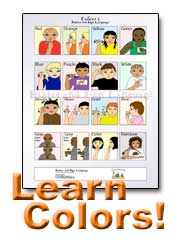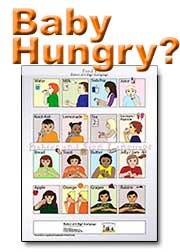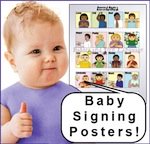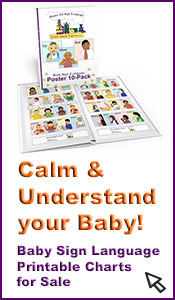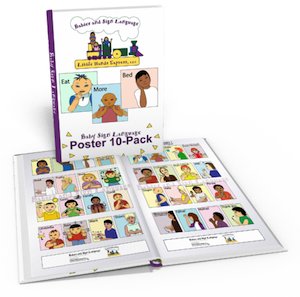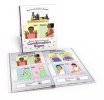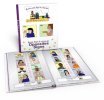Why Would You Teach a Hearing Child Sign Language?
by Carissa Martos
(Portland, Oregon)

My two signing kids (and me)
A few short years ago, if you'd seen a parent and child using American Sign Language in a park or at a store, it would have been safe to assume that one of the two was Deaf.
However there are now thousands of hearing parents teaching their hearing children how to sign basic words, due, in part, to the popularity of the hit PBS show Signing Time!
Baby signing classes are popping up all over the United States as parents proudly showcase their toddlers' approximations of MILK and MORE, and it isn't only infants that are learning signs. How, and why, did this phenomenon come about?
Speech and Language professionals have been using American Sign Language signs to help hearing children communicate with their parents for over 25 years.
The reason?
Babies often have the motor skills and ability to understand communication far earlier than they are ready to begin oral speech (Robertson, 2007), and parents have found that sign language allows them to communicate with their children at as young as six months of age.
Most people have seen pre-verbal children waving "bye-bye" before they can say it, or raising their arms in an attempt to get someone to lift them up, and teaching children American Sign Language signs is the next logical step.
Parents of signing children rave that their kids began talking early, grasped the concept of language very young, and have fewer temper tantrums because of their ability to communicate with their caregivers.
Sign Language is also embraced by many parents of children with speech and other developmental delays, as most Speech and Language Pathologists agree that sign facilitates the acquisition of verbal communication (Robertson, 2007). Simply put, it works.
What about other parents, though? Those whose children are already verbal, and able to hear? Is there any reason for parents to work on teaching signs to their older, healthy and developmentally typical children?
The benefits of teaching American Sign Language signs to preschool and elementary-aged children are threefold, positively affecting a child's cognitive, academic and social growth, besides the obvious advantage were the child ever to lose their hearing.
In the realm of cognitive development, it seems that children who learn sign have larger vocabularies than those who don't, and retain superior language skills even after they stop signing.
A recent study compared groups of children who were exposed to sign for a single school year - with groups who were taught a similar curriculum without the use of sign language (Robertson, 2007).
The researchers found that those children whose education had included manual communication developed better vocabulary skills during the year they were signing, and that they retained a larger vocabulary in the following year.
At the end of the multiple-year study, the researchers found that "the more varied ways a child is exposed to language, the more retention and learning of that language will take place" (Robertson, 2007).
A larger vocabulary would seem to be an academic boon, as well. However, knowing the rudiments of a second language gives a child an even more impressive edge on their classmates, and American Sign Language is recognized as its own language, separate from English (Wilcox, 1999).
Most parents know that learning a second language is important, and the proliferation of early immersion programs at the elementary level show that Portland parents have grasped that younger children learn and retain new languages much easier than older children and adults.
However, a York University study seems to indicate that having a second language actually changes the way the brain works, which allowed ?bilingual children to outperform monolingual students on tasks involving...abstract thinking, planning, initiating and inhibiting actions? (Exchange, 2010).
Experience with another language is also a requirement for most colleges and universities in the United States.
So, it seems that signing with your child will make them smarter and help them do better in school, but did you know that it can also help them make the world a warmer and more inclusive place for others?
Rachel Coleman, the creator of Signing Time! (and its Emmy-nominated star) has shared how her Deaf daughter, Leah, was ostracized on the playground and on her soccer team because the other children mistakenly believed she couldn't communicate with them.
After a boy on Leah's soccer team refused to play with her, Rachel took a chance at the local school and volunteered to read and sign a story to the little boy's class.
At the next practice, the boy rushed up to Leah signing, 'FRIEND-PLAY-BALL!'? Rachel continues, "He wasn't fluent in ASL. He hadn't taken an ASL course. He only remembered three signs. Three signs changed their world!" (Examiner, 2010).
Rachel's story illustrates how just a few signs mean that when a hearing child meets a Deaf child at school or encounters someone signing at their neighborhood park, the two won't have a language barrier to their friendship.
So, why do the parents of hearing children insist on their children learning American Sign Language signs? Because the knowledge will be good for their minds, good for their grades, and good for their hearts.
_________________________________________
Exchange Magazine. (2010). "Bilingualism boosts children?s focus, lessens distraction: York U study." Editorial. Retrieved from:
http://www.exchangemagazine.com/morningpost/2010/week5/Wednesday/020311.htm.
Robertson, Shari. (2007). "Using Sign to Facilitate Oral Language: Building a Case with Parents." Speech Pathology.com. Retrieved from: http://www.speechpathology.com/Articles/article_detail.asp?article_id=315.
Sedlock, Heather. (2010). Examiner. "Signing Time Videos to be aired on Nick Jr: Interview with
creator Rachel Coleman." Retrieved from: http://www.examiner.com/x-/x-10560-Special-Needs-Kids-Examiner~y2010m1d4-Signing-Time-Videos-to-be-aired-on-Nick-Jr-Interview-with-creator-Rachel-Coleman.
Wilcox, Sherman. (1999). "American Sign Language as a Foreign Language". Center for Applied Lingusistics. Retrieved from: http://www.cal.org/resources/digest/ASL.html.


